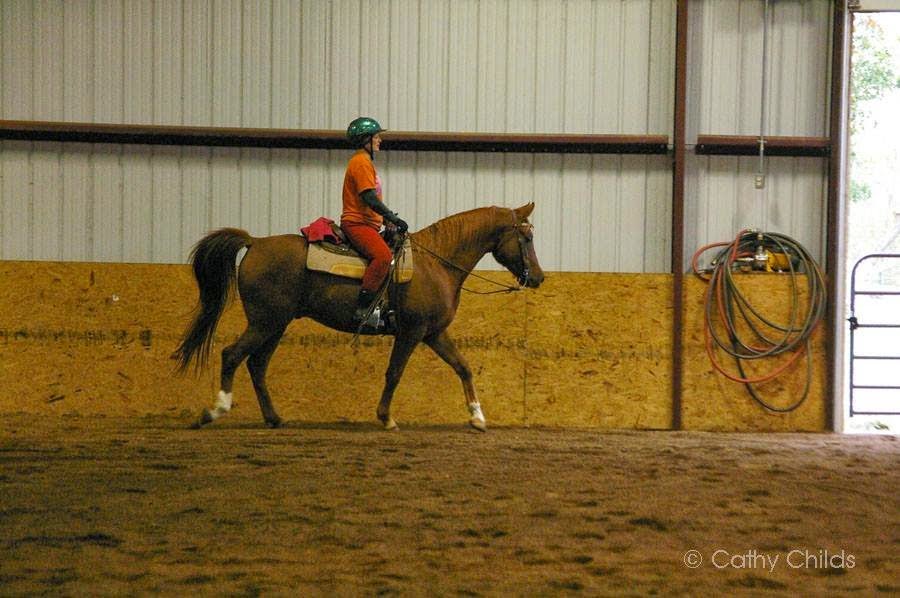Monday, October 27, 2014
When I learned to ride over 30 years ago I was taught how to sit correctly on the horse when riding so that I was seated correctly and so that I was balanced in the saddle. This may be “Old School”, but it’s still valid today and more riders need to learn this method.
Riders need to sit up straight and tall in the saddle. Sit centrally in your saddle looking ahead into the direction you are moving. Heels pushed downward with the ball of your foot in the stirrup/iron. Your toes should be pointing forward and higher than your heel with the inner leg wrapped around the horse.
Your hands should be held level above the wither of the horse while your wrists should be straight with the thumb uppermost. The upper arm relaxed with the elbows held into the side.
There should be an imaginary line that runs from the rider’s ear, through the shoulder, through the hip, and through to the heel. A second imaginary line runs from the bit in the horses mouth, through the rein, through the wrist, through the upper arm, and through to the elbow.
Here is breakdown of the rider’s postion:
• Eyes - need to be looking ahead into the direction that you are moving.
• Head - needs to be mobile and able to turn into the direction you are moving.
• Shoulders - care must be taken not to round the shoulders, but to keep them relaxed and mobile. This way, when the shoulders are closed, for example, when riding a half halt, the instruction will be understood by the horse.
• Elbows - should be relaxed to allow the horses movement to flow through. The elbow should also hang loosely at the side of the rider’s upper body.
• Wrists - need to be straight and not curved inwards or outwards, with the thumb uppermost and on top of the rein.
• Fingers - need to be closed around the rein in order for a contact to be held, but mobile enough to allow the rider to squeeze and play with the rein to aid in turning and softening of the rein.
• Back - needs to be held tall, straight and relaxed to allow all of the horse’s movement to flow through the rider without jarring.
• Hips - need to be mobile and non restrictive to allow the horses movement to freely flow through the rider’s body.
• Seat Bones - the rider’s weight is channeled equally through both of the seat bones. When riding lateral exercises slightly more weight can be placed into the inside seat bone.
• Waist - needs to be able to turn through, in order to follow the horse’s movement, care must be taken not to tip in and collapse through the waist when riding a turn or lateral work.
• Thighs - the inner thighs need to be held in close contact with the horse, as this gives a secure upper leg.
• Knees - need to be flexible and have the inner aspect in close contact with the horse.
• Calfs - need to have the inner aspect wrapped around the horse, and it is from the calf downwards that the lower leg nudges the horse forwards.
• Ankles - should be mobile and facing forwards.
• Heels - the rider’s weight needs to be pushed downwards into the heels, this helps the lower leg to wrap around the horse.
• Toes - should be pointing up and positioned to face forwards.
• Ball Of The Foot - the ball of each foot should be positioned onto the stirrup iron, to help to keep the foot in the correct position.
I see so many riders today, riders of all ages and levels, who don’t follow this method. It’s important to have a balanced proper seat for your safety in the saddle. Many people today have their stirrups/irons too short or too long - not at the proper length - and their foot positioned too far into the stirrups/irons. I see riders who aren’t sitting centrally in the saddle but are off to the left or the right. It’s important for your safety that you keep the balls of your feet in the stirrups, your heels down and sit in the center of the saddle so if the horse does spook or stumble you won’t be unseated as easily.
It may be “ old school”, but it’s the proper and safe way to ride.
Subscribe to:
Post Comments (Atom)
My Thought For Today
Over the past few years I have seen more and more 40-50-60 plus riders choosing to participate in extreme trail and obstacle events I'...

-
Trail class has been around for some time and is certainly well known, but there is a relatively new trail class, that is an ...
-
Recently I read a training tip (so to speak) that was posted on Social Media from a well known clinician and, once again, I was flabbergast...
-
There are six little words that can strike terror in the heart of a trainer/instructor. You ask what those six little words are - well t...



No comments:
Post a Comment